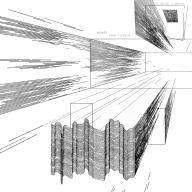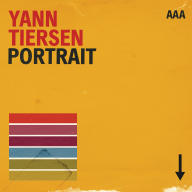Born in Brest in Brittany on June 23, 1970, Tiersen was raised in Rennes and made a name for himself as one of the star pupils at his local conservatory. He studied violin and piano from the ages of six to 14, and eventually trained to be a conductor. However, Tiersen rebelled against his classical training and, inspired by the likes of Joy Division and the Stooges, played guitar with several local post-punk-influenced bands during his later teenage years. He also recorded on his own with a synthesizer, sampler, drum machine, and eight-track recorder.
Not long after, Tiersen began composing scores for short films and plays. Several of these pieces ended up on his first album, Le Valse des Monstres. Released in June 1995 by Sine Terra Firma with a run of 1,000 copies, its pieces were written for stage adaptations of Tod Browning's classic 1932 underground film Freaks and Yukio Mishima's play The Damask Drum, an interpretation of a 15th century Japanese Noh play. Like many of his albums to come, Le Valse des Monstres featured intricate arrangements incorporating toy piano, banjo, harpsichord, melodica, and carillon, as well as piano and guitar. Tiersen played all of these instruments both in the studio and in concert, giving his early one-man shows a theatrical appeal and earning him a spot performing in 1996's Avignon Festival. However, Valse des Monstres and its follow-up, 1996's Rue des Cascades, were largely ignored by the public and by critics.
His third album, 1998's Le Phare, met a different fate. Recorded during a solitary two-month stay on the isle of Ushant, its single, "Monochrome," which featured vocals by French pop star Dominique A., was a radio hit and propelled the album -- and Tiersen -- to mainstream success in France. Le Phare became his first charting album, reaching number 50 on the French Albums Chart. In the wake of this acclaim, he contributed music to films such as Alice et Martin and La Vie Rêvée des Anges and worked with several likeminded artists, including Noir Désir and the electro-rock group Bästard. Black Sessions -- a live album of a 1998 radio performance -- featured Dominique A. and the Divine Comedy's Neil Hannon, as well as Les Têtes Raides and the Married Monk. The collaborative spirit spilled over into Tiersen's next full-length, Tout Est Calme. Featuring Claire Pichet, Olivier Mellano, and the Married Monk, the album appeared in 1999 and hit number 45 on the French Albums Chart.
Following work with the Divine Comedy and Françoiz Breut, Tiersen was preparing his next album when he was contacted by Jean-Pierre Jeunet, who wanted Tiersen to score his upcoming movie, Amélie. Jeunet had heard Tiersen's music while driving and had been so taken with it that he bought all of Tiersen's albums. Arriving in 2001, his Amélie score featured works from his previous albums as well as new compositions that he wrote in just two weeks. The film's success spun off to Tiersen's music: Amélie topped the French Albums Chart and also charted in several other countries, while Tiersen won the César Award for Best Music Written for a Film as well as the World Soundtrack Award for Best Original Score of the Year. His next proper album, 2001's Absente, featured collaborations with Lisa Germano, as well as longtime contributors Hannon and Dominique A. and the Ensemble Orchestral Synaxis. After its June 2001 release, it sold 100,000 copies in France. Throughout that year and 2002, Tiersen embarked on ambitious tours of France and the U.K.; these dates were chronicled in 2003's live album C'Était Ici. Later that year, his score for Good Bye Lenin! arrived, and earned a German Film Award for Outstanding Music.
Tiersen spent the rest of the 2000s alternating between film and pop music. In 2003, he worked with Tindersticks' Stuart Staples, singer/songwriter Christophe Miossec, actor/singer Jane Birkin, and Dominique A. on 3 titres inédits au profit de la FIDH (3 New Tracks for the Benefit of FIDH), an EP benefitting the International Federation for Human Rights. The following year, he teamed up with Shannon Wright for Yann Tiersen Shannon Wright and appeared on the Divine Comedy's Absent Friends. For his fifth album, 2005's Les Retrouvailles, he reunited with several of his frequent collaborators, as well as Cocteau Twins' Elizabeth Fraser and the Orchestre National de Paris. Tiersen's shows in support of the album spawned the 2006 live set On Tour. Two years later, his score for Tabarly, a documentary about the French Navy officer and sailor who perished in 1998, arrived.
In 2008, Tiersen began work on his sixth album, Dust Lane. Grieving the loss of his mother and a close friend, he returned to Brittany and settled on the island of Ushant, where he recorded most of the album (later, he completed the album's sessions in the Philippines). Featuring simple songs fleshed out with lush electro-acoustic arrangements, Dust Lane appeared in 2010. Tiersen soon followed the album with Skyline, a continuation of the themes and sounds he explored on Dust Lane. Skyline was released in Europe in October 2011 and in the United States the following April. For 2014's post-rock-influenced 8 (Infinity), Tiersen recorded in Iceland and the Faroe Islands. He took a very different approach on 2016's Eusa: an album of solo piano pieces inspired by his home on the island of Ushant, it was preceded by a book of sheet music for its songs and a collection of field recordings featured on the finished product. The album reached number five on Billboard's New Age Albums chart in the U.S. Tiersen continued his celebration of Ushant -- and other locales dear to him -- with February 2019's ALL. Recorded at the Eskal, a community center, performance space, and studio built in an abandoned discotheque, the album mixed field recordings from Brittany, England, and California, and featured collaborators including Anna von Hausswolff. ALL peaked at number three on the Billboard New Age Albums chart. That December, Tiersen celebrated his body of work with Portrait, a generous collection of reinterpretations of his music that featured contributions from Gruff Rhys, Blonde Redhead, Sunn O)))'s Stephen O'Malley, and others. Named for a chapel in Ushant, August 2021's Kerber paid tribute to locations around the island with piano and electronics-based pieces constructed by Tiersen and producer Gareth Jones. Reaching number eight on Billboard's Classical Crossover Albums chart, the album's release was accompanied by a set of sheet music and a live broadcast from Ushant. Tiersen's next album sprang from experiments at the Eskal in preparation for his late 2021 performance at Superbooth, a Berlin festival celebrating synthesizers and modular gear. Combining intricate samples with driving beats, 11 5 18 2 5 18 arrived in June 2022. ~ Heather Phares, Rovi


















